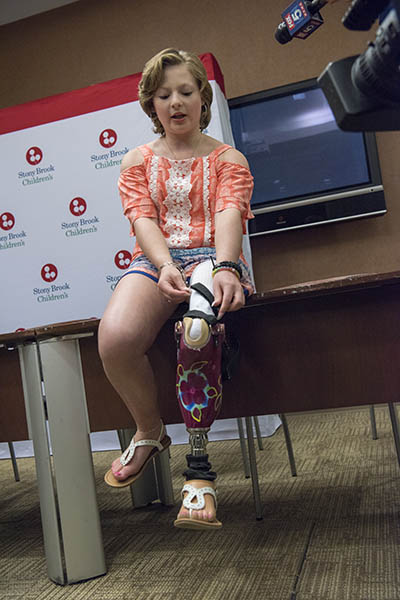Stony Brook Medicine offers a comprehensive range of diagnostic, treatment and follow-up services for patients with bone (orthopedic) cancers.
There are several different types of cancer of the bone. The surgeon discusses your medical history and the type and stage of cancer you have to create a personalized plan of care for you.
A Team Approach to Your Care
Surgeons work very closely with the medical oncologists and radiation oncologists on the Orthopedic Oncology team. They also collaborate with plastic and reconstructive surgeons and pediatric oncologists. The team plans the best course of treatment and discusses their recommendations with you and your family members.
Types of Surgery
Our surgeons use various techniques to physically remove tumors or visible cancer cells. At Stony Brook, our goal is to use the least invasive method possible. Surgical options include:
- Traditional or open surgery
- Minimally invasive laparoscopic surgery
- Robotic-assisted surgery
Surgery is often the primary treatment for bone cancer. That includes removing some of the surrounding bone and muscle to be sure as much cancerous tissue is eliminated. At the same time, saving your limbs and their functionality is also an extremely important part of treating bone cancer. Sometimes, we can replace bone that has been removed with either bone from another part of your body or an implant.
In combination with surgery, we may use chemotherapy or radiation or both as part of your treatment. This is done either to shrink the tumor before surgery or to manage and control the tumor after surgery.
Complex Reconstructions
Complex reconstructions can be done on your joints, including elbows, shoulders, hips and knees.
Using Tantalum for Metastatic Bone Cancer
Currently, Stony Brook Medicine is one of the few institutions in the world using a new material, called tantalum, for joint replacements in patients with metastatic bone cancer.
Tantalum is a titanium-like material with a major benefit: it needs dramatically less “good” bone in order to attach to the replacement socket. For example, when bone cancer destroys a patient’s hip joint, traditional surgery is usually impossible because there is not enough of this good bone available. This can leave patients in agonizing pain, requiring large doses of pain medication, which, in turn, may leave them with a host of undesirable symptoms. Through the use of the tantalum material, surgeons can reconstruct the joint by attaching the new socket to the remaining bone. This not only gives patients more mobility and functionality, but it also substantially relieves their pain and decreases the amount of pain medication they may need.
Limb-sparing Surgery
Most primary bone cancers are in the arms or legs. Limb-sparing surgery is the main operation for these cancers. This means removing the cancer without removing the affected arm or leg. Your surgeon removes the area of bone containing the cancer and may replace it with a metal implant called a prosthesis or replacement bone either from another part of the body or from a bone bank. In some cases, the affected bone is taken out, treated with radiotherapy, and then put back into the body.
For information about limb removal (amputation), click here.
Additional Surgical Procedures
Innovative Surgical Technique at Stony Brook

Delaney Inger's Story
Child Experiences New Freedom after Innovative Cancer Surgery
Rotationplasty: Most Often Used for Children
Rotationplasty is one of several types of surgical procedures that can be used to treat malignant bone tumors such as osteosarcoma or Ewing sarcoma, which occur near a child’s knee (in the lower part of the femur or upper tibia bone). This procedure preserves the neurovascular bundle — the nerves and the vessels — with the remaining foot. The lower part of the tibia is attached to the femur and the ankle is used as a knee joint.
Rotationplasty is most often used for children under age 12 who have so much growing left to do that other types of limb-sparing surgery options may not work well. With rotationplasty, the bone will continue to grow with the child, and the prosthesis can be lengthened with that natural growth. Younger children are generally better able to retrain their brain to use what used to be their ankle as a knee and to adapt their walking patterns.
This procedure can also be a good option for older children who have a very large tumor for which complete removal would be difficult. Rotationplasty is an option as long as the main nerves in the lower leg can be saved to maintain leg function. One of the major benefits of this surgery is that it allows your child to maintain a very active lifestyle.

